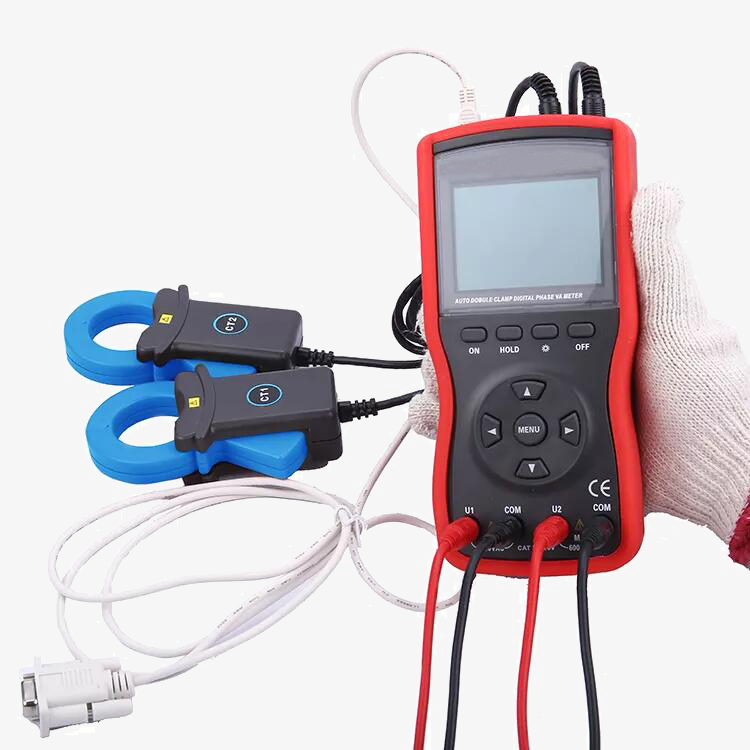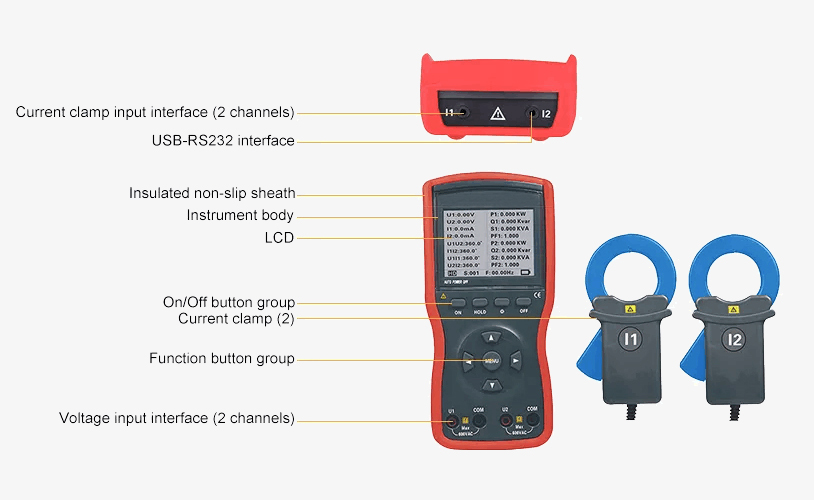Durable volt amp meter for sale online. It comes with a USB interface, 1200 groups of storage data, color LCD screen and high-insulation sheath. Digital volt and amp meter can directly measure AC voltage (0~600V), AC current (0mA-600A) and phase (0~360°) without opening the circuit under test, especially suitable for electric energy billing systems and relay protection systems.

Digital Volt Amp Meter, Current 600A, Voltage 600V, 35mm x 40mm CT size, USB interface for uploading the data.
- The volt amp meter has an intelligent design to reduce the complexity of the operation, and reduce the possibility of misoperation, with high precision, high stability, low power consumption, ease to use and other advantages.
- Digital volt amp meter features voltage transformer and current clamp to input, no high voltage inside the meter, complete isolation between 2 input channels, safe and reliable. The small sharp clamp is suitable for a flat cable-dense site.
- The test wire of volt ammeters adopts a special electric power cable, and all the plugs of the spring rod and crocodile clip have insulated protection. The meter is insulated with a nonslip sheath.
- sisco volt ampere meter is equipped with a USB interface and 1200 groups of data storage. Through the system software uploads the storage data to a computer, convenient for reading, saving, reporting, printing historical data, etc.
Details
Applications
Digital volt ampere meters can directly measure AC voltage, AC current, between two voltages, between two currents, and the phase between voltage and current and power frequency. sisco volt amp meters are suitable for electric power, petrochemical, metallurgy, railway, meteorology, industrial and mining enterprises, scientific research institutions, measurement departments, etc., especially for electric energy billing systems and relay protection systems.

| Model | SISCO-VAM-4020 |
| CT Size | 35mm x 40mm |
| Voltage Range | AC 0.00V~600V Error: ±(0.5% range) |
| Current Range | AC 0.0mA~600A Error: ±(0.5% range) |
| Phase Range | 0.0°~360.0° Error: ±1° |
| Frequency Range | 45.00Hz~65.00Hz Error: ±(1.0 % range) |
| Active power Range | 0.0W~360kW Error: ±(1.0 % range) |
| Reactive power Range | 0.0var~360kvar Error: ±(1.0 % range) |
| Apparent power Range | 0.0VA~360kVA Error: ±(1.0 % range) |
| Power factor Range | -1.000~1.000 Error: ± 0.03 |
| Meter Weight | 1170g |
| Power Supply | DC9V Alkaline battery LR61.5V AAX6PCS |
| Detection Rate | About 2 seconds/times |
| Meter Dimension | 196mmx92mmx54mm |
| Display Mode | 2.8-inch TFT color LCD screen, display field: 58mmx44mm |
| Data Storage | 1200 groups |
| Data Hold | In testing, press HOLD key to hold the data, "HD"symbol display |
| Communication Interface | USB interface, storage data upload to computer, convenient to analyze management data |
| Auto Shut Down | 15 minutes after boot up, the meter shuts down automatically without any operation |
| Voltage Detection | When the battery voltage is lower than 7.2V, low battery symbol display, remind to replace battery |
| Cable Length | Test wire length 1.5m; current clamp wire length 2mxΦ5mm |
| Input Impedance | Test voltage input impedance: 1MΩ |
| Working Current | Max power consumption of open backlight: 135mA; Meter power consumption of closed backlight: 90mA |
| Accessories | Host: 1PCS; Current Clamp: 2PCS; Test wire: 4PCS; USB data cable: 1PCS; Meter case: 1PCS |
Q1: What is a volt amp meter?
A1: A digital volt amp meter is a high-precision, low-consumption, low-cost, portable, handheld, dual-channel input measuring instrument, specially designed for measuring voltage, current and phases on-site.
Q2: How a volt amp meter works?
A2: The volt-ampere meter adopts the clamp conversion method to input the measured current, so there is no need to disconnect the measured line during measurement. When measuring the phase between U1-U2, the two input circuits are completely insulated and isolated, thus completely avoiding the short circuit of the measured line caused by miswiring and burning the measuring instrument. This is the working principle of volt ammeters.
Q3: What can a volt amp meter do?
A3: When the circuit under test is not open, the volt ammeter can simultaneously measure two AC voltages, currents, phases between voltages, phases between currents, phases between voltages and currents, frequency, phase sequence, active power, reactive power, apparent power, power factor, etc., the volt amp meter can also identify the transformer wiring group, inductive and capacitive circuits, test the secondary circuit and bus differential protection system, read the phase relationship between the CTs of the differential protection groups, and check the watt-hour meter wiring and line equipment.
differential protection groups, and check the watt-hour meter wiring and line equipment.
Tips: Volt amp meter application in a test socket
When a device doesn't seem to be working properly, you can set the double clamp volt ampere meter to a test voltage and plug the leads into the outlet slots. If the digital voltammeter shows no voltage, you have a circuit problem that is preventing the flow of current. Or, you may find that moving the probe causes the meter to jump, which means the socket needs to be replaced. Through a volt ammeter, you may get a voltage reading that is much smaller than it actually is, indicating a circuit defect that needs attention.
Thank you for buying industrial test and measurement equipment on SISCO.com, all products sold by SISCO and the partner cover a 12 months warranty, effective from the date of receiving the products.
What is covered?
SISCO is responsible for providing free spare parts, and free technical support to assist the customer to repair the defective products until the problem is solved.
What is not covered?
- Product purchased from anyone other than a SISCO store or a SISCO authorized reseller.
- Expendable parts.
- Routine cleaning or normal cosmetic and mechanical wear.
- Damage from misuse, abuse or neglect.
- Damage from use of parts other than SISCO approved.
- Damage from use outside the product’s usage or storage parameters.
- Damage from use of parts not sold by SISCO.
- Damage from modification or incorporation into other products.
- Damage from repair or replacement of warranted parts by a service provider other than a SISCO authorized service provider.
- Damage caused by the application environment not meeting the product usage requirements and the failure to perform preventive maintenance.

